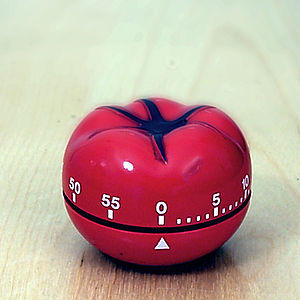Mark Forster recommended the use of timers in his book Get Everything Done and Still Have Time to Play. It sort of starts with the idea of timeboxing, a demarcated bit of time within which you choose to work on a specific task. A teacher may set aside 45 minutes to grade papers, say, and then take a 15-minute break. The teacher has timeboxed that task for 45 minutes and included a break, since if she simply sat and plowed through all of the papers in a single setting her brain would curdle and the last papers in the pile would have less of her focus and attention than did the first papers.
Forster recommended various ways to attack high-resistance tasks using a timer and timeboxing. One that I remember was to set a timer for 5 minutes with a one-minute break, then 10 minutes, then 15 minutes, etc. Focusing on the high-resistance task (or even a list of tasks) is easier when you agree with yourself to focus for only five minutes. Oftentimes that can be enough to get the ball rolling, and I find myself wanting to continue past the appointed time. It's important, though, to STOP what you're doing when the timer goes off. Your agreement with your mind is that you'll only work when the timer is active and then you'll take a break; your mind needs to know it can trust you. It's how you can get it on your side.
Forster had several other patterns in his book (one of them was a 5-10-15-20-25-30-25-20-15-10-5 sequence), all with the intention to help you get through the initial chaos of a high-resistance project or task and to ease you into doing the work you need to get done. Also, in these seemingly small margins of time, you will actually accumulate several hours worth of work. Oftentimes, just getting started is the hardest thing, and little tricks like this can be tremendously useful for just that purpose.
In recent years, the Pomodoro Technique has held sway and it's the one I tend to use the most often at home and at the office. It's kind of boggling to imagine that the simple idea of a 25-minute timebox has spawned web sites, apps, blog posts, ebooks, etc. In the old days, that probably would have been 2 pages in a chapter of any decent time management book.
An interesting twist on the timebox is the decremental timebox system (hat tip to a poster at Mark Forster's FV forum for the link). I've not used it much yet, but it's a rather fascinating idea.
I use two timers. At the office, I use the Time Timer, which is nicely visual and utters a little beep at the end of a session. (If I'm away from my desk when the timer goes off, I prefer the timer not drone on loudly for several seconds, thereby annoying my cubemates.) At home, I use the Datexx Miracle Time Cube (which is a winner simply for the name alone). It only offers 5-15-30-60 minute intervals, but it's dead easy to use and fun, which otherwise, why bother?

